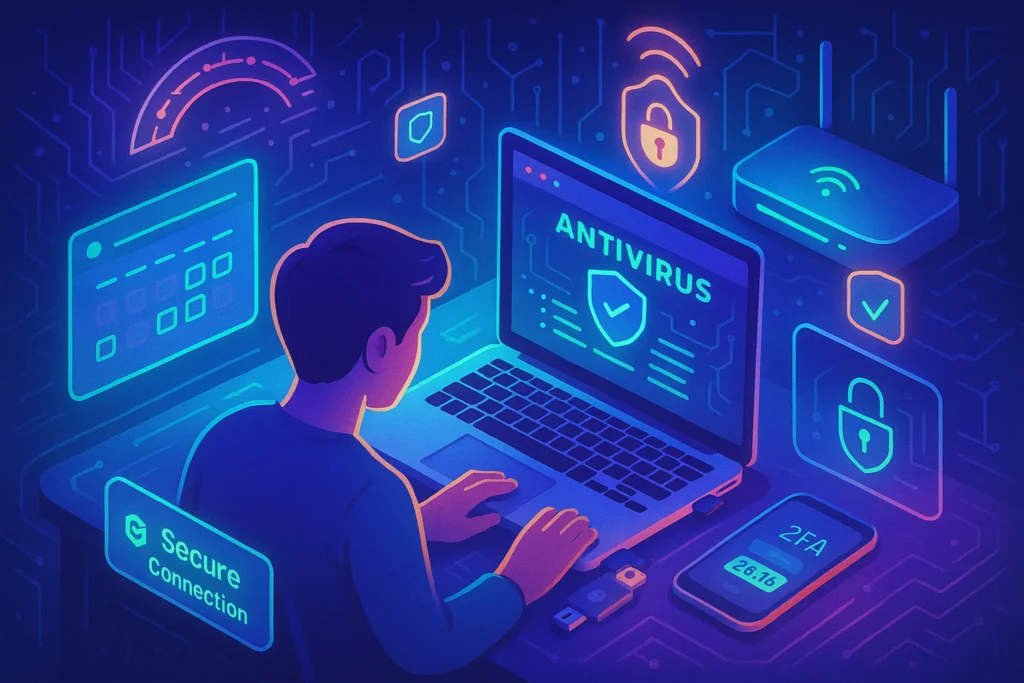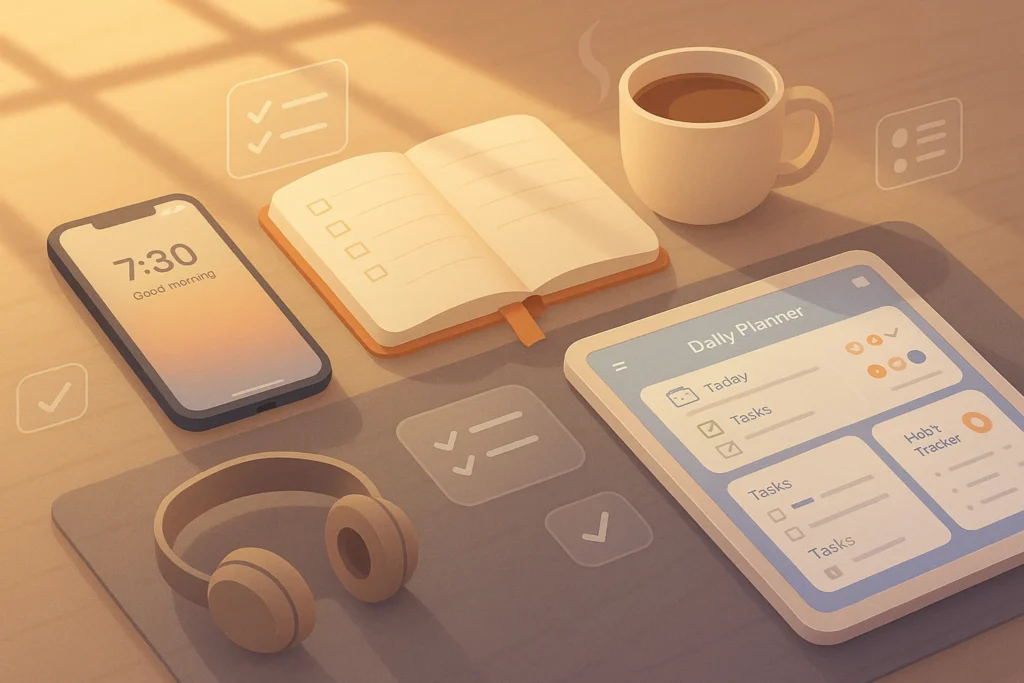🔐 Why Cyber Threats Are Growing in 2025
Cyberattacks are no longer just targeting governments and large corporations. In 2025, individuals and small businesses have become prime targets for hackers, ransomware groups, and phishing scammers.
🚨 According to IBM’s 2025 Global Threat Report:
-
Over 65% of all ransomware attacks in Q1 were aimed at SMBs
-
Phishing attacks have grown by 41% compared to last year
-
Average downtime after a breach is now 7.8 days
The increasing complexity of digital systems, plus the rise of smart homes and remote work, means we’re all operating with larger attack surfaces than ever before.
If you think antivirus software alone is enough, think again. You need layers of protection, each covering different types of risk—just like a fortress.
🛡 Multi-Layered Security Approach – Explained
Think of cybersecurity like a medieval castle: the moat, the outer wall, the guards, the inner keep—all working together. Your digital life deserves the same kind of layered defense:
🧰 Trusted Security Software
A trusted security suite is your first and most obvious line of defense. It’s like having a 24/7 digital bodyguard that watches for viruses, ransomware, spyware, phishing attempts, and other malicious behavior.
But not all antivirus tools are created equal. In 2025, you need more than just a basic scanner—you need a comprehensive suite that includes:
-
Real-time protection
-
Anti-phishing filters
-
Ransomware protection
-
A smart firewall
-
Web protection for browsing and downloads
Why it matters:
Most threats are designed to slip past outdated or free tools. Trusted suites like Bitdefender Total Security or ESET Smart Security use AI-based threat detection and cloud intelligence to protect you from zero-day exploits.
How to use it effectively:
-
Install on all devices (PC, Mac, smartphone)
-
Enable automatic scans and real-time monitoring
-
Use parental or user-level controls in multi-user environments
-
Keep the software updated at all times
It’s the base layer—don’t skip it.
👉 Also check out our breakdown in Cybersecurity Tips for Everyday Users for baseline safety practices.
🌐 Safe Browsing Habits
Most cyberattacks don’t start with “hackers in a basement”—they start when someone clicks the wrong link. In 2025, phishing attacks are smarter, fake websites look real, and one careless moment can cost your identity or your business.
Why it matters:
Safe browsing habits minimize your exposure to risky content and social engineering scams—by far the most common form of cyber threat.
What smart browsing looks like:
-
Always double-check URLs before clicking
-
Never download attachments from unknown sources
-
Use privacy-first browsers like Brave, or Firefox with extensions like uBlock Origin, Privacy Badger, and HTTPS Everywhere
-
Avoid entering personal info on sites that don’t have HTTPS or feel suspicious
-
Turn off autofill features for passwords and credit cards
Your brain is your best defense—but backing it up with browser tools helps a lot.
Use browser extensions that flag suspicious websites and automatically block trackers. Brave, Firefox with uBlock Origin, or DuckDuckGo browser are solid choices.
📱 Mobile Security Matters
Most people secure their laptops but forget their smartphones—despite using them for banking, messaging, 2FA, email, and even as house keys or wallets. Mobile devices have become prime targets.
Why it matters:
Malware, spyware, rogue apps, and public Wi-Fi risks are rising. If your mobile gets compromised, it could expose your entire digital footprint.
Best practices:
-
Always use biometric or PIN lock
-
Avoid sideloading apps (i.e. apps from outside Google Play or the App Store)
-
Review and revoke unnecessary app permissions regularly
-
Install system updates as soon as they’re available
-
Use secure apps like ProtonMail for email and Signal for messaging
-
Don’t connect to public Wi-Fi without a VPN
Your phone holds your life—treat it with the same caution as your passport.
Mobile safety is also key for smart home users—see Smart Home Gadgets to Simplify Your Life to understand how vulnerable your IoT ecosystem can be.
🔑 Advanced Protection Tips: Go Beyond Basics
To truly stay ahead of modern threats, you need to go deeper than antivirus. Here are pro-level techniques that can dramatically boost your digital security:
🔐 Use Hardware Security Keys
Passwords can be stolen. SMS codes can be intercepted. But hardware security keys like YubiKey or Google Titan offer something radically more secure: physical proof that you are you.
Why it matters:
They block 99.9% of phishing attacks—even if someone knows your username and password. These small USB-C or NFC devices work as your second factor in 2FA, and they’re supported by Google, Microsoft, GitHub, Facebook, and many others.
How to use it:
-
Register the key with your most sensitive accounts (email, cloud, banking, admin tools)
-
Tap the key (USB or NFC) whenever a login challenge is triggered
-
Keep a backup key in a secure location
They’re incredibly simple to use—and almost impossible to bypass.
📬 Want More Cybersecurity Tips That Actually Work?
Join our free newsletter and get practical security advice, privacy tools, and pro-level tips—tailored for creators, founders, and remote workers.
No fluff. Just what you need to stay secure.
🔐 100% privacy. No spam. Just battle-tested tools from NerdChips.
🧭 Harden Your Browser
Your browser is the window to the internet—and attackers constantly try to break it. Hardened browsing means configuring your browser and environment to reduce tracking, block known threats, and minimize surface area for exploits.
Why it matters:
Out-of-the-box browser settings are often optimized for convenience, not security. That makes you easy prey for fingerprinting, tracking scripts, and malicious redirects.
How to harden your browser:
-
Use Brave for automatic tracker blocking
-
Use Firefox + privacy extensions (NoScript, Cookie AutoDelete, ClearURLs)
-
Turn off third-party cookies and disable JavaScript on untrusted sites
-
Disable autofill for forms, passwords, and credit cards
-
Regularly clear your cache and site data
Hardening your browser is one of the most effective but overlooked steps in digital hygiene.
🔹 Pair with a password manager like 1Password to create and store strong, unique credentials for every site.
🧷 Network Segmentation
You wouldn’t let your baby monitor or smart fridge have direct access to your company files—yet that’s exactly what happens on a flat home or office network.
Why it matters:
When devices like smart TVs, security cameras, or even printers share the same network as your work laptop, a vulnerability in any one device can allow an attacker to reach everything else. Network segmentation separates them.
How to do it:
-
Use guest networks for IoT devices
-
On more advanced routers, set up VLANs (Virtual LANs) to isolate device groups
-
Disable remote access and UPnP (Universal Plug and Play) unless absolutely needed
-
For small businesses: use a dedicated router/firewall (like UniFi or pfSense)
This is critical if you work remotely or run a small business from home.
🔁 Update and Patch Discipline
Cybercriminals don’t need to invent new exploits—they often use known vulnerabilities that haven’t been patched.
✅ Automate Your Updates
Most cyberattacks don’t exploit brand-new vulnerabilities—they hit targets that never applied already-known fixes. That’s why patching is one of the lowest-effort, highest-impact things you can do.
Why it matters:
Vendors regularly release updates to patch security holes. Ignoring them leaves you wide open to attacks that are already preventable.
How to stay updated:
-
Turn on auto-updates for your operating system, browsers, and apps
-
Regularly check for firmware updates for your router, smart devices, and peripherals
-
Use patch management tools like Patch My PC (for individuals) or Ninite Pro (for teams)
-
Set a calendar reminder for monthly manual checks, just in case auto-update fails
This is digital hygiene 101—and yet it’s often neglected.
🛠 Patch Management Tools
For small teams or freelancers, tools like Patch My PC or Ninite Pro help manage software updates across multiple machines with minimal effort.
This practice is your easiest defense—and it’s often overlooked.
🚨 Real-World Attack Vectors in 2025
Cyber threats aren’t just theoretical—they’re evolving fast and targeting everyday systems. Here’s a snapshot of actual attack vectors dominating 2025:
-
📩 Google Docs phishing invites – Fake collaboration links that steal credentials
-
🧩 Malicious browser extensions – Disguised as productivity tools but used for spying
-
📷 QR Code scams – Printed or digital codes that lead to fake login pages
-
🔄 Fake app updates – Spoofed notifications to download malware (e.g. Zoom, Chrome)
-
📡 IoT exploitation – Hackers accessing networks through unpatched smart devices
Knowing how attackers strike is your first step to outsmarting them.
✅ Quick Cyber Risk Self-Checklist
Want to know if you’re truly secure? Score yourself 0–2 on each item below:
| ✅ Statement | 0 | 1 | 2 |
|---|---|---|---|
| I use unique passwords for all major accounts | ☐ | ☐ | ☐ |
| I’ve enabled 2FA or hardware keys | ☐ | ☐ | ☐ |
| My devices auto-update OS & apps | ☐ | ☐ | ☐ |
| I browse using a hardened/private browser | ☐ | ☐ | ☐ |
| My home Wi-Fi is encrypted & segmented | ☐ | ☐ | ☐ |
| I’ve backed up important data securely | ☐ | ☐ | ☐ |
| My devices are biometrically/PIN locked | ☐ | ☐ | ☐ |
| I can spot a phishing attempt quickly | ☐ | ☐ | ☐ |
Score Guide:
🟥 0–3 = 🚨 High Risk
🟨 4–6 = ⚠️ Medium Risk
🟩 7–8 = 🛡 Good Shape
💡 Tip: Even one weak area can be exploited. Use this list to strengthen your weakest link today.
🏛️ Why Cybersecurity Is No Longer Optional (Regulatory Angle)
In 2025, cybersecurity isn’t just a personal or technical concern—it’s also a legal and business requirement.
Why it matters:
Governments, insurers, and clients are now demanding proof of protection. If you’re a freelancer, agency, or run a small business, failing to meet security standards can cost you real money and reputation.
Key regulatory shifts:
-
The NIS2 Directive in the EU now covers medium-sized tech and digital service providers
-
GDPR fines can apply to negligent data protection or preventable breaches
-
MFA (Multi-Factor Authentication) is being mandated across industries like fintech, healthcare, and SaaS
-
Some cyber insurance providers won’t offer coverage unless certain protections (like 2FA or antivirus) are in place
Cybersecurity is now a compliance issue, not just a best practice. Even if you’re solo, you can’t afford to ignore it.
👉 See how this connects to long-term strategy in Cybersecurity in 2025
🧠 Nerd Verdict
Cybersecurity in 2025 is about layers, not luck.
-
One tool won’t protect you.
-
One good habit won’t save you.
But when you combine trusted software, behavioral awareness, secure hardware, and disciplined patching—you create a system that’s resilient, even when targeted.
Most cyberattacks today rely on laziness and outdated systems.
Your defense starts with intentional action—right now.
If you’re ready to level up, start by picking just one weak point in your system—and fix it today.
❓ FAQ: Nerds Ask, We Answer
💬 Would You Bite?
Which layer of your digital defense is currently the weakest—your passwords, your devices, or your habits?
Drop a comment and let’s help you fix it. 💬



